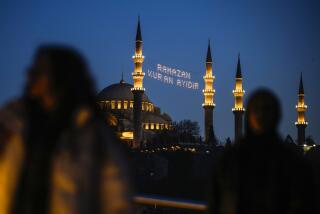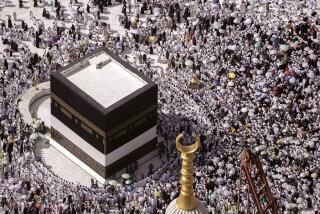Islam’s Sacred Script Survives the Centuries
- Share via
Before Mohamed Zakariya copies the words of the Koran, he washes his face, hands and feet as if he were going to pray. The pen he writes with is made from a reed that was buried in manure for four years to achieve the correct red color. His ink is soot ground to powder, a process he describes as shoulder-busting labor. The paper is dyed with tea, coated with egg whites, which makes it easier to correct mistakes, then set aside to age for at least a year. Muslim calligraphers have worked this way since the 7th century.
The results can be beautiful but may seem caught in the past when viewed in “Letters in Gold: Ottoman Calligraphy from the Sakip Sabanci Collection, Istanbul” at the Los Angeles County Museum of Art through May 17. Zakariya, though, is among a growing number of American Muslims who are keeping Islamic calligraphy alive.
“It was the highest form of Islamic art,” Linda Komaroff, LACMA associate curator of Islamic art, says of the Ottoman style. Works in the show date from the 15th to the 20th centuries. “The people who carry on the tradition now tend to love the act of writing. They may come to it from a devotion to the word and what it can express. And they need some familiarity with Arabic, the liturgical language of Islam.”
For Muslims, Arabic is sacred. Jews hold Hebrew in the same esteem; Hindus revere Sanskrit. In many religions, the very act of writing is considered holy. While Muslims who hand-copy the Koran describe it as a spiritual occupation, Christians feel the same about the Bible, Jews about the Torah, Hindus about the Vedas, the four Hindu texts of devotional hymns.
“Inside religious traditions, people believe the sacred word is powerful because it emits from God,” says Philip Novak, author of “The World’s Wisdom” (HarperSanFrancisco, 1994), which highlights the sacred texts of the major religions. “Muslims believe Allah spoke through Arabic.
“Written down, the words point us toward the sacred, to where our hearts ought to be. That makes words the most sacred signs we have,” Novak says.
Zakariya, 56, first studied calligraphy in 1980 after he converted from Christianity to Islam. That led him to the Center for Islamic History, Art and Culture in Istanbul, Turkey. Raised in Ventura, now living in Arlington, Va., he is considered one of the most accomplished calligraphers in the United States. Yet he often returns to Turkey to refresh his skills.
He wrote the script that decorates the banners advertising the LACMA show, translated the catalog from Turkish and loaned his handmade paper for the exhibit. He’s also giving lecture-demonstrations at the museum.
The texts he chooses are the same that the Ottoman masters have copied for 500 years. There are phrases from poetry, the sayings of the prophet Muhammad and especially the words of the holy book.
“The Koran is always best written in calligraphy,” Zakariya says. “A carefully handwritten copy contains a spiritual overflowing. The calligrapher’s religious faith has a lot to do with it.”
He compares such a copy to a more typical version, set in mechanical type. “It’s like a Mozart clarinet concerto played on a harmonica,” he says. “It’s just not the same.”
Royal edicts were the only political documents significant enough to be written in sacred script during the Ottoman Empire. Sometimes, politics and religion intersected. Sultan Mahmud II, who ruled from 1808 to 1839, was a student of calligraphy. One of his works, on view at LACMA, reads: “I cannot have success except with the help of God.”
The sultan’s bold, ornate signature was designed for him by his teacher, Mustafa Rakim. Some of the greatest calligraphers, however, wrote in small letters and attached humble comments to their names. “Dust at the feet of the prophet” or “the humble slave,” for example. Others signed in the tiniest letters imaginable.
Just like teachers in the age of the sultans, Zakariya trains students without charge. Born in Afghanistan, Ferozuddin Noori, 27, was 12 when he started. Noori now lives in Richmond, Va., not far from Zakariya’s home.
He practices about six hours a week and also attends college. After 13 years, he sees himself as a beginner. “The teacher has a very important job,” he says. “He has to keep the student going and help him fall in love with calligraphy, even though it can be frustrating.”
It is not unusual for a beginner to rewrite a single phrase for months at a time and never get it quite right. One exercise book on view at LACMA captures the frustration. Between every line with its correction marks, the teacher has written, “Persevere.”
Although he is a professional calligrapher and woodworker, Syrian-born Ghassan Jabr, who now lives in West Los Angeles, keeps a stack of exercise books near his work table. It seems every calligrapher sees himself as a perpetual student. His tile-like pieces decorate the walls of the Damascus airport and Syrian mosques, as well as religious schools and private homes in Los Angeles.
The floral designs in Jabr’s work are stylized, rather than realistic, to remind him of a fundamental rule in Islamic art. “What God creates we do not try to compete with,” Jabr says. Human images in particular are forbidden, but the Ottoman calligraphers found another way to capture the prophet Muhammad. They made “word portraits.”
One, taken from a description by his son-in-law, Ali, reads in part: “He was not too tall, nor too short. His eyes were black. He had long eyelashes. He had thick hands and feet. When he walked, he walked inclined, as if descending a slope. When he looked at someone, he looked at them in full face.”
“Calligraphy is a response to the prohibition to draw human forms,” says Jane Smith, professor of Islamic studies at Hartford Seminary in Connecticut. “There is no image of God in Islamic art, either. The closest we get is a mental picture made of the 99 names, the attributes of God found in the Koran.” Two of them, “the compassionate, the merciful,” open every chapter of the book and are perhaps the most popular words in Islamic sacred writing.
Nasreen Haroon of Santa Monica commissioned Jabr to inscribe those attributes on her dining room wall. The words are surrounded by a floral design that blends with the colors of the room and looks, at first, like a decoration. “It is my way of being grateful to God,” she says. “It reminds me to be grateful.” In her native Pakistan, most Muslims would have something religious on view in their home. Many of the pieces in the LACMA show were commissioned to be used in the same way.
The demand for such commissions remains small in the United States. Zakariya is one of a few American Muslims who can support himself as a calligrapher. School teachers, college professors and government workers are his main customers. When he saw the Ottoman calligraphy show, he could not help but compare his own work. “It’s very humbling,” he admits. “You look at the good stuff and say, ‘I’ll never catch up to that.’ ”
More to Read
Sign up for Essential California
The most important California stories and recommendations in your inbox every morning.
You may occasionally receive promotional content from the Los Angeles Times.













